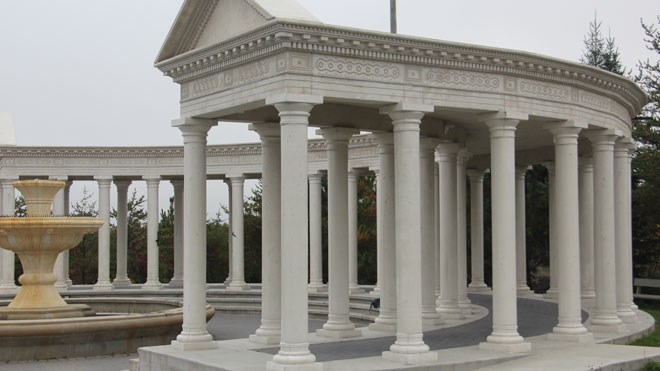The Grotto of Our Lady of Lourdes, built on a high elevation of rock in 1907, provides a bird’s-eye view of downtown Sudbury although it is hidden by the growing city.
Tucked in behind Van Horne Street, it had become difficult to access and had fallen into disarray for many years until community volunteers realized their vision for a park for prayer in 2007. The grotto was voted Best Hidden Gem by Sudbury.com in 2017.
The grotto site has always been considered an important site for prayer and religious gatherings by the city’s Francophone Roman Catholics, but it has become an ecumenical place of worship. People of all faiths are welcome.
For example, the Ten Commandments, installed in 2007 and engraved on two boulders from Manitoulin Island, are written in Hebrew, French and English. A labyrinth was designed and built by parishioners from St. Peter’s United Church.
In 2016 about 1,000 people attended a fundraising concert there for local good causes. It is also a popular spot for wedding photography.
It is a place of “peace, love and respect,” said Father Ronald Peron. His first visit to the grotto was in 1952 when he was a student at Collège Sacré-Coeur. He has returned many times to pray, say mass or lead pilgrimages.
Peron was the chaplain of the Our Lady of Lourdes shrine for a time and contributed to writing its history, “The Grotto of the Mountain, 100 Years of Prayer 1907 to 2007.”
How did the Grotto, which represents the story of the Virgin Mary’s appearance to a 14-year-girl in Lourdes, France, in 1858, happen to be built in Sudbury just 20 years after a Canadian Pacific Railroad crew blasted through the hard rock around Ramsey Lake?
The Grotto was built by Frédéric Romanet du Caillaud, a wealthy French businessman who visited Sudbury periodically from 1902 until 1914. Like so many other adventurers, he was looking for mineral wealth.
He would come to be known among Sudburians by the nickname “the Count of Sudbury.” While one online resource states du Caillaud was actually a member of the French nobility, Ontario400.ca maintains that the title was simply a nickname. Du Caillaud may have built the shrine as a memorial for his son who died in 1897 or as a plea to restore the health of his ailing wife.
According to Grotto’s official history, “Others seem to think that Romanet built the grotto as a form of intercession to the Holy Virgin, hoping that she would help in his search for gold and nickel in Sudbury.”
“There was a large gathering at the train station when the six- foot (bronze) statue, believed to come from France, arrived,” says Perron.
Four hundred people attended a ceremony for the official blessing of the site held in English, French, Italian, Latin and Greek in 1909.
Local histories, including “Sudbury 125,” published by Northern Life in 2008, record the count never discovered minerals. At one time, his property extended along the entire length of the north shore of Ramsey Lake, including the Minnow Lake area.
A road that runs along the shore of the lake is named for him as are the islands Frédéric and Romanet in Minnow Lake. Streets in the downtown area, Tarneaud and Sirorac, were named after family members.
In 1914 at the beginning of the First World War, du Caillaud returned to France. He died there in 1917 and his Sudbury properties reverted to the city due to unpaid taxes.
For a time, the property was cared for by the Drago family, who were friends of du Caillaud. In 1951, the pastor of Sainte-Anne des Pins raised $4,000 to purchase the Grotto property from the city.
In June 1952, more than 10,000 Roman Catholics took part in a large pilgrimage to the site to celebrate the Feast of Corpus Christi.
In 1958 additional property was purchased and the Ladies of the Sudbury Rosary Club of Sainte-Anne du Pins parish raised $38,000 to install the Stations of the Cross.
But by the 1980s, the Grotto site was a forgotten landmark and was in deplorable condition. Members of the Rosary Club were discouraged that no amount of money could prevent the site from being vandalized.
In 1992 the Knights of Columbus took over responsibility for maintenance. In 1996, Ernie Savard became chair of Friends of the Grotto and led the campaign for money, muscle and materials to upgrade the site which included purchasing land and creating an entrance off Van Horne, and install a fountain, gardens, and stone monuments.
Much of the work and materials were donated by city business families.
Renamed the Grotto of the Mountain site, it more commonly known by its original name.
“It is a place of peace, where people can go just to be quiet and by themselves,” says Perron.
Early in the summer of 2020, the Stations of the Cross were vandalized. Numerous cast iron figurines were beheaded. Perron says police have had no leads. The Lougheed family has offered a reward for information about the vandalism.
“The vandals have to be prejudiced or very sick people. They had to have intent. They had to have tools to cut cast iron.
“That is sad to see in our society people cannot respect other’s faith or culture or their colour,” adds Perron.
The Friends of the Grotto committee is now looking at the possibility of installing surveillance cameras to deter future vandalism.
Vicki Gilhula is a freelance writer in Greater Sudbury. She will be back with another Then & Now story about local history in two weeks.
